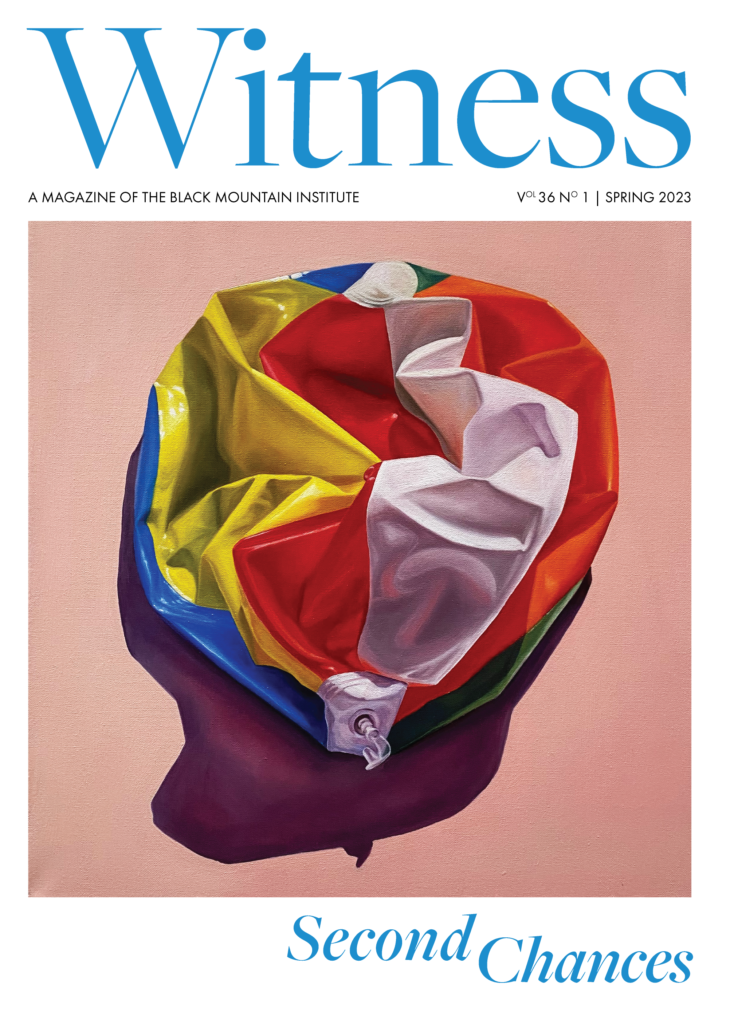what should I know
to save you that I do not know . . . ?
—Jorie Graham, “The Dream of the Unified Field”
I.
Instead of winter, a cache of ashes, my grandfather
threshed then yielded to air. I’ll say graupel when I mean
I’ve spooned from his urn masqueraded with cloisonné blossoms.
Hail, when I mean I’ve clutched my inheritance until
it has flown. Not tempest, but effigy exhaling.
What’s left of him seducing a swarm of super
cooled clouds, the love affair gone as it matrixes
through gust. I watch him ease back into atomic
ordering. Sutures of bone interlacing in wind.
His body confabulating like stars through a barrage
of sky. I watch his body glitter the air
like diamonds. I watch him rise through sun-stained fields
of soybeans, deform the ether with his vector field,
each fleck of him a stippled star.
II.
How long have I stood at this highway guardrail,
watching his body re-pattern? He’s crystal now,
avalanche, a system deferred by conversion.
How long have I watched his body rasp in the squall?
At skyline, he riots. I’m lured by his stroboscopic motion.
I trace his dervishes through each illumination angle—
tangent plane. Surface normal. I watch him,
susurration in the sky’s braille of snow.
He loiters in my gaze, radiant before
he’s swallowed again. The wind’s turned his body
to coordinates, a swarm which obeys the sun’s scattered
urges, its streaks of chartreuse and coral. Is this
what it means to taper into confluence, to haunt
the spaces where the body, in ecstasy, threw open its wings?
III.
He’s a man testing the limits of a field that will never
hold him long—1983, Christmas
tree, his blue satin bathrobe kitschy in the flash.
Tinsel’s fervent across a topography of fake
needles, candy canes splicing rouge against pale.
Nothing interrupts the spray of ornaments
but his eyes detained by the camera’s tear of light.
Later, he’s lax across the sheet-strewn Chesterfield,
calico pillow slipped between his thighs.
His coffee table’s laden with Chardonnay, a geometrical
ashtray filled with half-smoldering butts. Smoke roams
the air. I don’t want to know where his pants have gone,
why my grandmother’s snapping this mise en scène. Where
in our memories do these aphasias hang, chafed by reality?
IV.
Memories, not collimated rays sharp in the flash.
My grandfather in bathrobes, gingham sweaters, knot-softened
ties caressing his neck. My grandfather in Speedos
on the patio chaise when he suns with breakfast mimosas,
lazes like Ingres’ Grande Odalisque, drunk
past symmetry. Christmas 1987,
and he poses under my grandmother’s quilt, aperture
in motion, the day conceded to fingers of gin.
The last light blazes through half-open blinds, his face
rashly chiaroscuro. I’m seven, and the limits
of my world are dust pixelating in air
which hazards another threshold. Flash. Click.
Light vignettes, cuts the scene to saturation.
What is a photo stripped to its final exposure?
V.
Stripped by exposure, he dazzles in the haze—
not man but calamity of hair, white underwear,
a mute insurgence live-wiring me to his luminance.
I have no words for the quilt that falls with his body,
the animal, serpentine, that rises with his breath.
No words for why he’s trusted with girls—
sisters, nieces, the next ripe surge of daughters,
why my aunt won’t leave him alone with her son.
I don’t know how long his blackout will vibrate across
this room, the years, or how such scenes become
the lattice-work of family recall.
I learned to carry the referent of my grandfather,
not his wreckage. His invisible latent image. To ask,
was he body—really body—or negative?
VI.
His ashes, glossy as silver halide, lift
toward a light that divulges: effigy exhaling, sutures
of bone. As the wind takes over, I watch him disband
in a spectral valence until everything darkens, turns
infrared. He’s a collage of signs enticing
the next great signifier. Vanished words traipsing
the boundaries of ether, his dove-grey traces riveting
the air. I dust off his relics in my palm’s taut lines
that won’t revive the sky or fields of soybeans,
estrange a highway already clenched by ice.
He’s a flurry of encoding, a vector radiating—
referent, not wreckage. Latent image. Aphasia,
not exposure, not the limits of his world: nothing remains
of his final luminance. Nothing remains.







